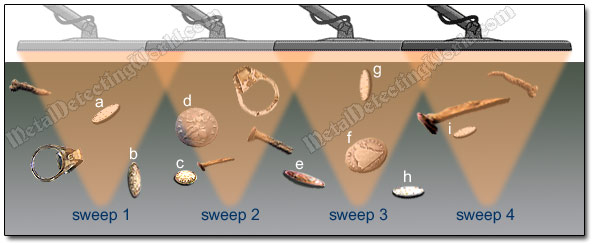Search Coils for Metal Detectors, page 9
Search Coil Swinging Discipline in Details
Sweep Overlapping with Concentric Search Coils
(...CONTINUED from previous page)
The second illustration shows that three more coins could be easily detected when 25% overlapping is taking place.
25% Overlapping of Concentric Search Coil Sweeps

The coin "d" in sweep 2 would be a little problematic to ID because of the pull-tab positioned in close proximity - this would produce a combination of two signals of different tones (if Tone ID is used) or an average between them, or two signals of the same tone character (if your detector is operated in a single-tone mode) but different sound.
The problem here is not the tones of audio responses, but the quality of each signal. In any case (Tone ID or not), both signals may be very broken or "chirpy" due to the positioning of both targets - both are standing on edge! The search coil methods for "separation" of targets, detecting "coins on edge," and identification of questionable targets are described on page 14, page 16 and page 19 respectively.
The rest of this scenario could unfold taking same turns as in the first case described above. At least, in this case, an inexperienced detectorist would leave less coins undetected. To get more coins easy way, one should increase the overlap percentage.
The third illustration shows the coin "c" getting fully encompassed and coin "e" partially being "touched" by the electromagnetic field detection pattern when 50% overlapping is taking place.
50% Overlapping of Concentric Search Coil Sweeps

50% overlapping would yield much better results in reality than in my illustration. It is just that the picture format does not allow me to "paint" a more realistic picture of target positioning and density. In real world, if a hunt site contained as many coins per one square meter of ground coverage as shown in my illustration, this would be a fanatstic hunt site, and every inch of the ground would be investigated, and every target would be dug up!
If to place all sweeps that were shown in previous illustrations into one picture, we get an interesting situation: three spots that may or may not contain coins are missed by the detection patterns of all sweeps - "no overlap," "25% overlap" and "50% overlap," combined. On picture below, those spots are 1) location of coin "b", 2) location of coin "e", and 3) location of coin "h."
Electromagnetic Field Detection Patterns of All Sweeps Combined

Based on this observation, I can conclude that even if you metal detect the same area three times following the same direction of search, each time increasing the sweep overlaps by 25%, you would still leave roughly 25% of the underground soil unscanned due to the physical shape of the electromagnetic detection field of your concentric coil. This is another reason why we find deep-buried coins at "hunted out" sites.
To decrease the percentage of undetected underground that falls within the reach of your coil's electromagnetic detection field, you can do the following:
1) increase the sweep overlap up to 75%
2) rework a hunt site at angles perpendicular and oblique to the original search patterns or gridding patterns
3) use search coils of different sizes and switch them during each hunt to get most of valuable targets out of the hunt site (see details on coil sizes on page 5) or
4) use Double-D (or Wide Scan) search coils (see details on page 3).